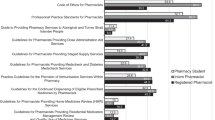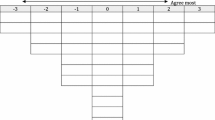Summary
This article reviews and describes the formulary decision-making process in an academic medical centre. The pharmacy and therapeutics (P & T) committee is the organisational nucleus of the drug use control process in the institutional environment. Thomas Jefferson University Hospital (TJUH). a 720-bed academic medical centre in an urban locality in the US, is used as a model representative of how most of these committees function. Survey responses collected from 29 peer academic medical centres arc presented to compare and contrast the structure and function of the P & T committee at TJUH with corresponding procedures in other university hospitals in the US.
TJUH is typical of the institutions which comprise the University Hospital Consortium (UHC). The P & T committee of TJUH is composed of 29 members, meets once per month for 10 months of the year, and has a network of 13 subcommittees. TJUH has an intermediately controlled (mixed) formulary, and uses both restricted drugs and treatment guidelines. Of the 29 UHC member institutions responding to the survey. the average P & T membership is 18, the average meeting frequency is 11 times per year, and 83% of these committees have a network of subcommittees, None describe their formulary system as open, 86% have a closed formulary and 14% have a mixed formulary system. There is a restricted drug programme in 76% of the institutions, 79% utilise treatment guidelines, 76% practice therapeutic interchange and all employ generic substitution.
Specific areas addressed in this review include the history of the formulary system, the structure and function of the P & T committee, types of formularies, cost containment and the formulary decision-making process. the impact of organisational culture on physician decision making. the role of the pharmacy department, the role of pharmaceutical sales representatives and their impact on prescribing habits, the impact of the Joint Commission on Accreditation of Healthcare Organisations (JCAHO) Agenda for Change on the formulary process, and future challenges.
Similar content being viewed by others
References
Abramowitz PW, Fletcher CV. Counterpoint: Let’s expand the formulary system and renew its vigor. American Journal of Hospital Pharmacy 43: 2834–2838, 1986
Achusim LE. Therapeutic interchange as a cost-containment measure. PharmacoEconomics 2: 347–351, 1992
Adams TD, Burleson KW. Continuous quality improvement in a medication error reporting system. P&T 17: 943–952, 1992
American College of Physicians. Position paper: therapeutic substitution and formulary systems. Annals of Internal Medicine 113: 160–163, 1990
American Society of Hospital Pharmacists. ASHP statement on the formulary system, American Journal of Hospital Pharmacy 43: 2839–2841, 1986a
American Society of Hospital Pharmacists. ASHP statement on the pharmacy and therapeutics committee. American Journal of Hospital Pharmacy 43: 2841–2842, 1986b
American Society of Hospital Pharmacists. The formulary system: brief history and 1960’s perspective. American Journal of Hospital Pharmacy 43: 2838–2839, 1986c
American Society of Hospital Pharmacists. Practice standards of ASHP 1991–1992, American Society of Hospital Pharmacists, Bethesda. Maryland. 1991
Ault A. Drug utilization review: apocalypse when? Medicine and Health Perspectives 24: 1–4, 1992
Avorn J, Soumerai SB. Improving drug therapy decisions through educational outreach: randomized controlled trial of academically based detailing. New England Journal of Medicine 308: 1457–1463, 1983
Avorn J, Harvey K, Soumerai SB. Information and education as determinants of antibiotic use: report of task force 5. Reviews of Infectious Diseases 9 (Suppl. 3): S286–S296, 1987
Bamberger DM, Dahl SL. Impact of voluntary vs enforced compliance of third-generation cephalosporin use in a leaching hospital. Archives of Internal Medicine 152: 554–557, 1992
Bootman JL, Townsend RJ, McGhan WF. Principles of Pharmacoeconomics, Harvey Whitney Books Company, Cincinnati, Ohio 1991
Brown CH. Physician acceptance of drug-therapy recommendations using a written data and communications form. American Society of the Consultant Pharmacist 6: 729–734, 1991
Cano SB, Fujita NK. Formulary evaluation of third-generation cephalosporins using decision analysis. American Journal of Hospital Pharmacy 45: 566–569, 1988
Cascio MV, Williams JM. Impact of a nonformulary drug notification form. American Journal of Hospital Pharmacy 39: 1039–1041, 1982
Chan J, Einarson TR. Drug detailing in the hospital: background for policy development. Canadian Journal of Hospital Pharmacy 44: 161–166, 1991
Cook AA, Sanchez ML. A multidisciplinary process to determine, communicate, and manage an antibiotic formulary. Hospital Pharmacy 27: 867–882, 1992
Coppola P. A successful pharmacy-directed formulary restriction of H2-antagonists. American Society of Hospital Pharmacists, Annual Meeting 47, Boston, Abstract P-7D, 1990
Curtiss FR. Pharmacy management strategies for responding to hospital reimbursement changes. American Journal of Hospital Pharmacy 40: 1489–1492, 1983
Daniels CE, Wertheimer AI. Analysis of hospital formulary effects on cost control. Topics in Hospital Pharmacy Management 2: 32–49, 1982
Davern PF, Kubiea AJ. Controlling drug costs: administrative and clinical strategies. Topics in Hospital Pharmacy Management 7: 48–58, 1987
Eisenberg J. Doctors decisions and the cost of medical care. Health Administration Press, Ann Arbor, Michigan, 1986
Epstein AM. Changing physician behavior - increasing challenges for the 1990s. Archives of Internal Medicine 151: 2147–2149, 1991
Gervase JS. Major antibiotic formulary changes: convincing the docs through clinical interventions and persuasion techniques. ASHP Midyear Clinical Meeting 25, Las Vegas, Abstract Pl–24, 1990
Hennessy S, Strom BL. Issues in hospital-based drug use evaluation, P&T: 733–754, 1992
Himmelberg CJ, Pleasants RA, Weber DJ, Kessler JM, Samsa GP, et al. Use of antimicrobial drugs in adults before and after removal of a restriction policy. American Journal of Hospital Pharmacy 48: 1220–1227, 1991
Hinnant JT, Grapes ZT. Formulary management activities in Georgia. ASHP Midyear Clinical Meeting 25, Las Vegas, Abstract P–94E, 1990
Hinnant JT, Grapes ZT. Formulary management activities in Georgia. P&T 17: 475–478, 487-488, 1992
Ioannides-Demos LL, Eckerl GM, McLean AJ. Phartnacoeconomic consequences of measurement and modification of hospital drug use. PharmacoEconomics 2: 15–33, 1992
Joint Commission on Accreditation of Healthcare Organizations. Accreditation manual for hospitals 1992, Joint Commission on Accreditation of Healthcare Organizations, Chicago, Illinois, 1991
Kepler JA. Drug therapy review - coumarin and indandione derivatives. American Journal of Hospital Pharmacy 30: 705–713, 1973
Kitlel JF, Swalzell RH, Williams MP. Forrester CW, Bancroft WH. Development or a flexible formulary for a Veterans Administration hospital. Hospital Formulary 13: 46–48, 1978
Lawrenz C, Theodorou A, Cook R, Cole P. Formulary interchange: ampicillin/sulbactam for cefoxitin. Abstract of Meeting Presentation, ASHP Midyear Clinical Meeting 24, Atlanta, Abstract P–34D, 1989
Lee HE. Coping with DRGs: Evanston hospital, Evanston, Illinois. American Journal of Hospital Pharmacy 40: 1508–1509, 1983
Lewis RP, Moore TD. P&T committee perspectives: achieving an effective committee through reorganization: the Ohio State University Hospital’s experience. Hospital Formulary 26: 120–124, 129-130, 1991
Lichstein PR, Turner RC, O’Brien K. Impact of pharmaceutical company representatives on internal medicine residency programs - a survey of residency program directors. Archives of Internal Medicine 152: 1009–1013, 1992
Lingle EW, Reeder CE, Kozma CM. Impact of an open formulary system on the utilization of medical services. Journal of Research in Pharmaceutical Economics 2: 93–123, 1990
Linkewich JA, Prevoznik SJ. Guidelines on the operation of the pharmacy and therapeutics committee and formulary. Hospital Pharmacy 14: 7–22, 1979
Lovly R. Total quality management and the P&T committee. P&T 17: 953–962, 1992
Lumsdon K. As hospital drug budgets soar, pharmacy’s role is being rewritten. Hospitals 20: 34–40, 1992
Lyon RA. Use of general (tertiary) reference sources in a university hospital based drug information service. Hospital Formulary 19: 210–218, 1984
McEvoy GK. Obtaining references for AHFS drug information monographs. American Journal of Hospital Pharmacy 44: 1552, 1987
McEvoy GK. Unlabeled uses of drugs in AHFS drug information monographs. American Journal of Hospital Pharmacy 45: 1271–1272, 1988
Mutnick AH, Barenfanger J, Szymusiak-Mutnick B. Use of a multidisciplinary educational program - an alternative to pharmacy-initiated directives. P&T 17: 867–883, 1992
Myers CE, Pierpaoli PG, Smith MA. Measurement of formulary inclusion costs. Hospital Formulary 16: 951–976, 1981
Nash DB. Practice guidelines and outcomes - where are we headed? Archives of Pathology and Laboratory Medicine 114: 1122–1125, 1990
Nolte MJ, Sorrenlino AC, Ernst TF. Therapeutic drug class reviews: systematic evaluation of the hospital formulary. ASH P Annual Meeting 48, San Diego, Abstract MCS-13, 1991
Osborne JA. Coping with DRGs: Baptist Medical Center of Oklahoma, Oklahoma City. American Journal of Hospital Pharmacy 40: 1506–1507, 1983
Pearce MJ, Begg EJ. A review of limited lists and formularies: are they cost-effective? Pharmacoeconomics 1: 191–202, 1992
Price KO. Drug information center support of P&T commitlees - cost justification and fee-for-service activities. P&T 17: 632–641, 1992
Roberts RW. Coping with DRGs: Riverside Hospital, Jacksonville. Florida. American Journal of Hospital Pharmacy 40: 1500–1502, 1983
Rucker TD. The formulary process as it relates to drug utilization review. P&T 17: 646–657, 1992
Sangha KS, Gora ML, LeRoy ML. Innovative way of removing high use drugs from the formulary of a university leaching hospital. ASHP Annual Meeting 48. San Diego, Abstract P-77 D, 1991
Sass CM, Ashworth LE. Role of a drug information center in formulary management. ASHP Annual Meeting 48, San Diego, Abstract P-9D, 1991
Schumacher GE. Multiattribute evaluation in formulary decision making as applied to calcium-channel blockers. American Journal of Hospital Pharmacy 48: 301–308, 1991
Seltzer JL, Wordell CJ, Nash DB, Johnson NE, Gottlieb JE. P&T committee response to evolving technologies: preparing for the launch of high-tech, high-cost products. Hospital Formulary 27: 379–392, 1992
Sherman DS. Learning how to influence prescribing behavior. Contemporary Long Term Care 15(5): 70–84, 1992
Soumerai SB, Avorn J. Efficacy and cost-containment in hospital pharmacotherapy: state of the art and future directions. Mil-bank Memorial Fund Quarterly/Health and Society 62: 447–474, 1984
Soumerai SB, Ross-Degnan D, Gortmakcr S, Avorn J. Withdrawing payment for nonsciemiflc drug therapy - intended and unexpected effects of a large scale natural experiment. Journal of the American Medical Association 263: 831–839, 1990
Sutlers CA. Management of a hospital formulary. Journal or Clinical Pharmacy and Therapeutics 1: 1559–76, 1990
Thomas J. National survey of hospital policies on pharmaceutical sales represenlalives’ activities. American Journal of Hospital Pharmacy 44: 1334–1340, 1987
Thomas J. National survey of recent changes in hospital policies on pharmaceutical sales representatives’ activities. American Journal of Hospital Pharmacy 46: 565–569, 1989
Thomas Jefferson University Hospital Policy and procedures manual, Thomas Jefferson University Hospital, Philadelphia, Pennsylvania, 1992
Todd MW. Experience with a criteria-based formulary system. Florida Journal of Hospital Pharmacy 9: 29–37, 1989-1990
Upton JH, Crouch JB, Douglas JB. Coping with DRGs: the Moses H. Cone Memorial Hospital. Greensboro. North Carolina. American Journal of Hospital Pharmacy 40: 1496–1499, 1983
Weist CA, Falk D, Hancock BO, Molinari F. Drug information service directed formulary management: development of an oral potassium formulary. ASHP Annual Meeting 48, San Diego, Abstract P-I2D, 1991
Zellmer WA. Rethinking the formulary system concept - introduction. American Journal of Hospital Pharmacy 43: 2829, 1986
Author information
Authors and Affiliations
Rights and permissions
About this article
Cite this article
Nash, D.B., Catalano, M.L. & Wordell, C.J. The Formulary Decision-Making Process in a US Academic Medical Centre. Pharmacoeconomics 3, 22–35 (1993). https://doi.org/10.2165/00019053-199303010-00004
Published:
Issue Date:
DOI: https://doi.org/10.2165/00019053-199303010-00004




